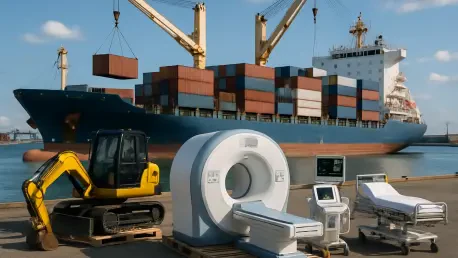In a world increasingly reliant on global supply chains, the United States faces a pressing question about the safety of depending on foreign imports for critical goods like industrial machinery and medical equipment, prompting urgent scrutiny. On September 2 this year, the U.S. Department of Commerce launched two significant investigations under Section 232 of the Trade Expansion Act of 1962, targeting robotics, industrial machinery, personal protective equipment (PPE), and medical devices. Announced for public comment on September 26, these probes aim to uncover whether such reliance poses a genuine threat to national security. With the potential for tariffs or quotas looming, the implications could ripple across industries, affecting everything from manufacturing capabilities to healthcare access. This isn’t merely a bureaucratic exercise; it’s a reflection of deep-seated concerns about vulnerabilities that could undermine the nation’s stability in times of crisis, prompting a reevaluation of trade policies that may reshape economic landscapes.
Understanding Section 232 and Its Role in Trade Policy
Historical Power of Trade Restrictions
Section 232 of the Trade Expansion Act of 1962 stands as a powerful tool, granting the U.S. President authority to impose tariffs or quotas on imports deemed a threat to national security. Historically, this provision has been wielded to protect key industries, with past administrations applying hefty tariffs—sometimes as high as 50%—on materials like steel and aluminum to shield domestic producers from foreign competition. Such measures were often justified as essential to maintaining economic and defense capabilities, especially when reliance on imports could leave the nation exposed during conflicts or emergencies. This legal framework isn’t just a relic of past policy; it remains a cornerstone of modern trade strategy, reflecting a belief that economic independence in critical sectors is synonymous with national strength. As these new investigations unfold, they carry forward a legacy of using trade restrictions to address perceived vulnerabilities, underscoring a consistent focus on safeguarding strategic interests.
The application of Section 232 has often sparked debate about balancing security with economic openness, as protective measures can lead to higher costs for consumers and industries downstream. While tariffs may bolster local manufacturers by reducing foreign competition, they can also strain international trade relationships and disrupt established supply chains. In the context of the current investigations, the historical precedent suggests a readiness to prioritize security over short-term economic efficiency. The focus on industrial machinery and medical supplies indicates a recognition of their indispensable role in both economic infrastructure and public health resilience. As public input is sought, the Commerce Department is likely to weigh these past lessons, considering how previous tariff implementations have shaped industries while assessing whether similar actions are warranted now. This historical backdrop provides crucial context for understanding the potential scope and impact of the outcomes that may emerge from these probes.
Current Push for Supply Chain Protection
Today, Section 232 investigations into machinery and medical gear highlight a persistent trend toward addressing supply chain vulnerabilities through a protectionist lens. This approach mirrors a broader governmental stance that views over-reliance on foreign goods as a risk to national stability, particularly in sectors vital to infrastructure and emergency response. The initiation of these probes signals an intent to scrutinize global dependencies, especially when imports are concentrated from a limited number of countries, heightening the danger of disruptions. Such concerns are not abstract; they are grounded in real-world scenarios where supply chain failures could cripple critical operations, from manufacturing plants to hospitals. The Commerce Department’s call for public comments reflects a desire to gather diverse perspectives on how to fortify domestic capabilities, ensuring that the nation is not left vulnerable by external forces.
Beyond immediate security concerns, this push for protection also ties into geopolitical strategies aimed at countering economic leverage held by adversarial nations. The fear that foreign entities could manipulate supply chains—through export restrictions or pricing tactics—adds urgency to the investigations. By focusing on robotics, industrial machinery, and medical equipment, the government acknowledges their dual importance to economic strength and public welfare. The public comment period, set to close on October 17 this year, offers stakeholders a chance to influence whether protective measures like tariffs will be deemed necessary. This current effort is not just about reacting to past crises but about proactively building resilience against future uncertainties. As these investigations progress, they may redefine how the U.S. approaches trade, prioritizing self-reliance over global integration in key areas where security cannot be compromised.
Scope of the Investigations
Critical Focus on Industrial Machinery
The first investigation targets robotics and industrial machinery, encompassing a broad range of programmable, computer-controlled systems like CNC machining centers, milling machines, and laser-cutting tools. This probe also includes components such as automatic tool changers and industrial ovens, with an estimated impact on half a trillion dollars in trade value. Such a staggering figure underscores the immense role this sector plays in U.S. manufacturing and infrastructure, serving as the backbone of industries that drive economic output. The government’s concern centers on foreign dominance in this field, where reliance on imported equipment could leave domestic production paralyzed in the event of supply chain disruptions. This investigation isn’t just about numbers; it’s about ensuring that the foundation of American industry remains secure against external pressures that could halt progress.
Delving deeper, the focus on industrial machinery reveals a strategic intent to assess whether the U.S. can sustain its manufacturing prowess without heavy dependence on foreign inputs. The sheer scope of products under review—from grinding equipment to specialty metalworking tools—highlights how integral these items are to daily operations across multiple sectors. A key worry is the concentration of supply from a few foreign sources, which could amplify risks if geopolitical tensions or trade disputes arise. The Commerce Department is keen to understand if domestic production can scale up to meet demand or if protective measures are needed to incentivize local investment. This investigation serves as a litmus test for how far the nation is willing to go to protect its industrial base, potentially reshaping trade dynamics for years to come with policies that could either bolster or burden the economy.
Vulnerabilities in Medical Supplies
The second investigation zeroes in on personal protective equipment (PPE), medical consumables, and equipment, covering essentials like surgical masks, N95 respirators, syringes, ventilators, and MRI machines. These items are not just products; they are lifelines in healthcare settings, critical for patient care and emergency preparedness. The probe is driven by stark lessons from past crises, such as the COVID-19 pandemic, where shortages of critical supplies exposed dangerous gaps in global supply chains. The fear of being caught unprepared again looms large, prompting scrutiny of whether reliance on a handful of foreign suppliers leaves the U.S. vulnerable to sudden cutoffs or price gouging during public health emergencies. This investigation seeks to address a fundamental question of readiness in the face of unforeseen challenges.
Beyond immediate shortages, the concern extends to the broader implications of dependency on foreign medical gear, particularly when supply chains are influenced by foreign government policies or economic strategies. Items like hospital beds, insulin pumps, and diagnostic reagents are indispensable, yet their availability could be jeopardized by export restrictions or geopolitical maneuvers. The Commerce Department is exploring whether domestic manufacturing can realistically fill these gaps or if alternative sourcing strategies are needed to mitigate risks. Public health isn’t merely a domestic issue; it’s a national security priority, as a weakened healthcare system could undermine broader societal stability. As this investigation unfolds, it aims to ensure that the tools needed to save lives are not held hostage by international dependencies, pushing for a framework that prioritizes access and security.
Key Issues and Public Input
Evaluating Supply Chain Dependencies
A core focus of both investigations is the assessment of supply chain risks tied to foreign dependencies, with the Commerce Department seeking detailed public input on U.S. demand for the targeted goods and the capacity of domestic production to meet it. This evaluation isn’t just about current numbers; it’s about projecting future needs and identifying where gaps exist that could be exploited during crises. A significant concern is the concentration of imports from a small number of suppliers or countries, which could amplify the impact of disruptions, whether due to natural disasters, trade disputes, or deliberate actions. The government aims to map out these vulnerabilities, understanding how deeply embedded foreign supply chains are in critical sectors like manufacturing and healthcare, and whether such reliance compromises national autonomy in times of need.
Another layer to this assessment involves examining the influence of foreign government policies, such as subsidies or export controls, that might distort markets and harm U.S. industries. There’s a palpable worry that adversarial nations could weaponize supply chains, using access to essential goods as leverage in geopolitical conflicts. Public comments are crucial here, as they will help shape an understanding of whether domestic alternatives are feasible or if protective measures like tariffs are the only viable solution. The Commerce Department is also interested in how existing trade policies affect local manufacturing and whether adjustments could spur growth in key areas. This process of gathering input, set to conclude on October 17 this year, represents a pivotal moment to address systemic risks before they manifest into larger threats.
Balancing Security with Economic Realities
Public input is also sought on the broader implications of potential policy responses, particularly how to balance national security with economic realities. Protective measures like tariffs or quotas could shield domestic producers from foreign competition, potentially sparking investment in local manufacturing of machinery and medical supplies. However, such actions risk inflating costs for industries that rely on these imports, which could trickle down to consumers, especially in healthcare where affordability is already a pressing issue. The Commerce Department is keen to hear from stakeholders about the feasibility of scaling up domestic production without sacrificing efficiency or accessibility, a challenge that requires innovative solutions and possibly government support to bridge the gap during transitions.
Additionally, the investigations probe the impact of foreign pricing tactics and subsidies that might undercut U.S. manufacturers, creating an uneven playing field. There’s a need to understand if current trade frameworks adequately protect national interests or if new barriers are essential to level competition. Importers, meanwhile, face uncertainty about how potential tariffs might disrupt established supply chains, forcing them to seek costlier alternatives. The diversity of perspectives during the public comment period will be vital in crafting policies that don’t just react to security fears but also consider long-term economic health. This delicate balancing act is at the heart of the investigations, aiming to forge a path that strengthens resilience without derailing the interconnected global economy.
Potential Economic and Policy Impacts
Industry Shifts and Consumer Costs
The outcomes of these Section 232 investigations could trigger significant shifts within industries reliant on imported machinery and medical gear, with domestic manufacturers potentially gaining a competitive edge if tariffs or quotas are imposed. Such measures might encourage investment in local production, creating jobs and reducing dependency on foreign sources for critical goods. However, this comes with a caveat: higher costs for imported items could burden downstream industries, from construction firms using industrial equipment to hospitals needing affordable medical supplies. In healthcare especially, increased prices for essentials like ventilators or PPE could strain budgets, potentially limiting access to care for vulnerable populations. The Commerce Department must weigh these trade-offs, ensuring that security-driven policies don’t inadvertently harm the very systems they aim to protect.
Beyond immediate industry effects, the ripple impact on consumers cannot be overlooked, as higher costs often translate to pricier goods and services across the board. For instance, a spike in machinery costs could elevate the price of manufactured products, while expensive medical gear might drive up healthcare expenses. The scale of the industrial machinery probe, estimated at half a trillion dollars in trade, suggests an economic impact of unprecedented magnitude, touching nearly every corner of production. Public input will play a key role in highlighting these downstream consequences, offering insights into how protective measures might be structured to minimize harm. As these investigations move forward, the challenge lies in crafting policies that bolster domestic strength without placing undue financial pressure on businesses and individuals already navigating tight margins.
Challenges for Importers and Policy Uncertainty
Importers stand at a crossroads as these investigations unfold, facing the prospect of tariffs that could upend established supply chains and force a scramble for alternative suppliers. Such shifts often come with higher costs and logistical headaches, especially if new sources lack the efficiency or scale of current ones. The uncertainty surrounding whether existing exemptions—such as those for specific medical goods—will remain adds another layer of complexity, leaving businesses unable to plan with confidence. This is particularly acute for sectors like healthcare, where consistent access to affordable equipment is non-negotiable, and any disruption could have immediate, life-altering consequences. The Commerce Department’s request for public feedback aims to capture these concerns, ensuring that the importer perspective informs any final decisions on trade restrictions.
Moreover, the broader policy uncertainty tied to these investigations could chill investment and slow decision-making across industries, as companies wait to see how the trade landscape will shift. The potential for quotas or steep tariffs introduces a level of unpredictability that complicates long-term planning, especially for firms heavily reliant on foreign machinery or medical supplies. With the public comment window closing on October 17 this year, there’s a narrow opportunity for stakeholders to advocate for clarity and moderation in potential measures. The government faces the task of designing responses that address security risks without destabilizing the economic ecosystem, a goal that hinges on understanding the nuanced challenges importers face. This moment of policy deliberation could set a precedent for how the U.S. navigates the intersection of trade and security in an increasingly interconnected world.
Reflecting on Trade and Security Dynamics
Looking back, the initiation of these Section 232 investigations by the U.S. Department of Commerce marked a pivotal moment in addressing the intersection of trade and national security. The probes into robotics, industrial machinery, PPE, and medical equipment illuminated deep concerns about foreign supply chain dependencies that had long simmered beneath the surface of policy discussions. With billions of dollars in economic activity at stake, the process underscored a collective recognition that vulnerabilities in critical sectors could no longer be ignored. The public comment period, which closed on October 17 this year, provided a crucial platform for diverse voices to weigh in, shaping a dialogue that balanced security imperatives with economic realities.
Moving forward, the next steps should focus on crafting targeted solutions that strengthen domestic production without disrupting essential supply flows. Policymakers might consider incentives for local manufacturing, alongside strategic partnerships with allied nations to diversify sourcing and reduce risks. Investing in technology and innovation could also close capacity gaps, ensuring resilience in both industrial and healthcare sectors. As the outcomes of these investigations take shape, a collaborative approach—drawing on industry expertise and public insights—will be vital to fortify national security while preserving economic vitality for the future.









